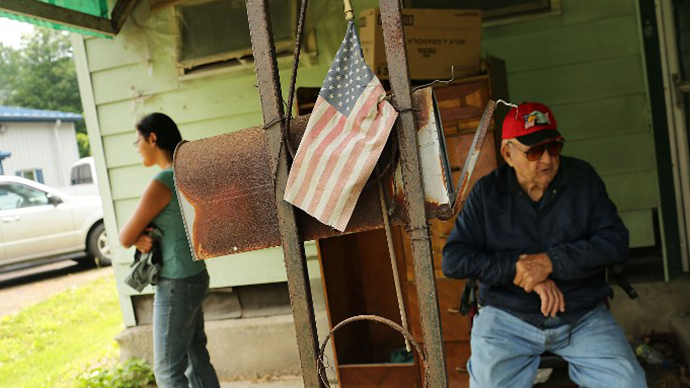RT
July 29, 2013
 Four out of five US adults come to grips with joblessness, near-poverty or reliance on welfare for at least some parts of their lives. Over 41 percent of the nation’s poor are whites, according to a new report.
Four out of five US adults come to grips with joblessness, near-poverty or reliance on welfare for at least some parts of their lives. Over 41 percent of the nation’s poor are whites, according to a new report.
In 2011, 46.2 million people in the US were living in poverty and the nation’s official poverty rate was 15 percent, up from 14.3 percent in 2009, according to the US Census Bureau. That figure appears to be the highest number seen in the 52 years for which poverty estimates have been recorded.
Although poverty rates for blacks and Hispanics are proportionately nearly three times higher, by absolute numbers the predominant face of the poor is white, the latest report shows. Economic insecurity among whites is said to be more common than is shown in the government’s poverty data, engulfing over 76 percent of white adults by the time they turn 60, according to a new economic gauge being published next year by Oxford University Press.
Pessimism has been steadily growing across the country, with 63 percent of whites describing the US economy as ‘poor’ in the most recent AP-GfK poll. It’s believed that he growing gap between rich and poor and the loss of good-paying manufacturing jobs are to blame.
“If you do try to go apply for a job, they’re not hiring people, and they’re not paying that much to even go to work,” a Buchanan County resident, 52-year-old Irene Salyers said, adding that where she lives children have “nothing better to do than to get on drugs.”
Almost one out of sixteen people in the USA are living in deep poverty. The risks of poverty have been growing in recent decades, especially among people aged 35-55. For instance, people aged 35-45 had a 17 percent risk of encountering poverty during 1969-1989; the risk increased to 23 percent during the period 1989-2009.
Over 19 million whites fall below the poverty line of $23,021 for a family of four, accounting for over 41 percent of the US destitute, nearly double the number of poor blacks, according to the survey data revealed by AP. By 2030 up to 85 percent of all working-age adults in the US will experience economic insecurity.
 Daily Stormer The Most Censored Publication in History
Daily Stormer The Most Censored Publication in History


